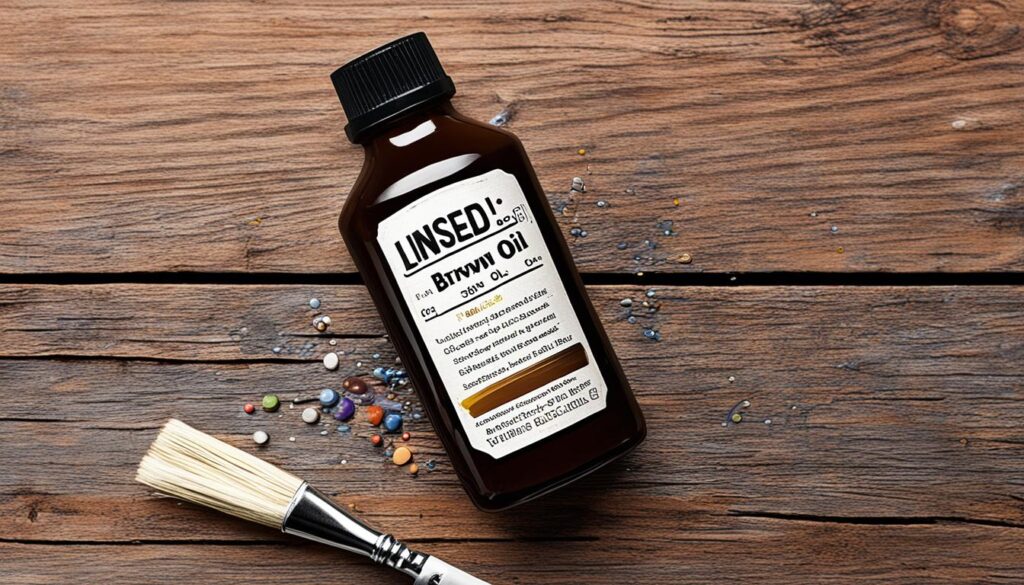Linseed oil drying time varies based on its formulation. Raw linseed oil, which undergoes oxidative polymerization, can take from 3-4 weeks to several months to dry fully. Boiled linseed oil, enhanced with metallic driers, typically becomes touch-dry within 24-72 hours. Enhanced drying conditions, such as temperatures between 15-25°C, low humidity, and good ventilation, accelerate the process. Applying the oil in thin, even coats and utilizing UV light can further expedite curing. In-depth understanding of these factors is essential for efficient drying and achieving excellent results. For deeper insights into optimizing your linseed oil application and drying process, continue exploring.
Understanding the Linseed Oil Drying Process
Understanding the linseed oil drying process requires a detailed examination of the oxidative polymerization that occurs as the oil absorbs oxygen from the air and gradually hardens into a durable film. This transformation involves complex chemical reactions where linseed oil undergoes oxidation, leading to the formation of crosslinked polymer networks.
The drying time for raw linseed oil is particularly prolonged, ranging from 3-4 weeks to several months, necessitating patience for complete curing time. In contrast, boiled linseed oil, which contains metallic driers such as lead or manganese, exhibits a considerably accelerated drying time, becoming touch-dry within 24-72 hours and achieving full cure within approximately one week.
The fundamental mechanism of linseed oil drying is its absorption of atmospheric oxygen. This oxygenation triggers the polymerization process, where the oil molecules interlink to form a solid film. The drying and curing rates are influenced by several factors including temperature and humidity. Elevated temperatures and lower humidity levels generally expedite the drying process, while cooler temperatures and higher humidity can retard it.
Additionally, the presence of metallic driers in boiled linseed oil acts as catalysts, enhancing the rate of oxidation and polymerization. Understanding these dynamics is essential for optimizing the application and performance of linseed oil finishes.
Factors Affecting Linseed Oil Drying Time
Several critical factors influence the drying time of linseed oil, each playing a pivotal role in the overall curing process. Temperature is paramount; ideal drying occurs between 15-25°C (59-77°F). Colder temperatures below 10°C (50°F) markedly prolong drying times. Humidity also impacts drying; low humidity levels expedite the process, whereas high moisture content in the air or on the surface retards it. Proper ventilation and air flow are essential, as they facilitate oxygen exposure necessary for oxidation.
UV light greatly aids in curing by initiating oxidation reactions, making sunlight exposure beneficial. Coat thickness directly affects drying time; thinner coats dry faster, while thick applications can trap moisture and delay hardening. Surface preparation is equally important. A well-cleaned, degreased, and sanded surface allows for better oil penetration and curing compared to contaminated surfaces.
The type of linseed oil used is another critical factor. Boiled linseed oil contains drying agents that accelerate the process, leading to faster drying to touch and full cure. In contrast, raw linseed oil lacks these agents, resulting in considerably longer hardening times. Therefore, understanding these factors can help optimize the drying time of linseed oil applications.
How Long Does It Take for Linseed Oil to Dry
The drying time for linseed oil is dependent on a combination of factors, with raw linseed oil requiring noticeably longer periods, ranging from 3-4 weeks to several months, for complete curing. This extended drying time is primarily due to the lack of drying agents, requiring ideal drying conditions. Thin coats of linseed oil are recommended to expedite the drying process, as thick coats can result in significant drying problems, including a gummy surface and incomplete crosslinking.
Boiled linseed oil, which incorporates metallic driers, offers a faster drying alternative, typically reaching a dry-to-touch state within 24-72 hours. However, achieving a full cure can still take up to one week. Proper application methods, such as degreasing the surface and ensuring consistent air circulation, are essential for uniform drying and to prevent issues like uneven curing or prolonged tackiness.
Exposure to sunlight and UV light can greatly enhance the drying process by accelerating oxidation reactions. Conversely, high humidity and low temperatures can slow down the drying rate, highlighting the importance of ideal environmental conditions.
Ultimately, understanding these variables and implementing precise application techniques can ensure a smoother curing process for linseed oil finishes.
Proper Application and Curing of Linseed Oil
Proper application and curing of linseed oil involve meticulous techniques to guarantee ideal penetration, drying, and durability. The process begins with the preparation of the wood surface, which includes thorough sanding to open the wood grain for better oil absorption. Application should be done using a clean cloth, brush, or steel wool, making sure the oil is worked in the direction of the wood grain.
After application, the oil must be allowed an induction time of 15-20 minutes to penetrate before wiping excess oil off the surface. This step is essential to prevent gummy buildup and promote even drying.
The drying process primarily relies on oxidative drying and evaporation, where oxygen exposure facilitates photochemical oxidation, transforming the liquid oil into a solid film.
Environmental factors like temperature, humidity, and oxygen availability have a considerable impact on the curing time. High temperatures and good air circulation accelerate drying, while a low-oxygen environment or dew can impede the process.
For raw linseed oil, it is advisable to wait at least 72 hours between coats and up to several months for a full cure. Boiled linseed oil, which includes drying agents, requires 24-48 hours between coats and approximately one week for complete curing.
Drying Linseed Oil Indoors vs. Outdoors
Understanding the nuances between drying linseed oil indoors versus outdoors is essential for achieving the best results and efficiency in the curing process. The indoor application of linseed oil is often hindered by the lack of direct UV exposure, which greatly slows down the photochemical oxidation reactions essential for drying. Indoor environments typically offer less ventilation, creating a low-oxygen scenario that retards the oxidative drying process. Conversely, warm temperatures and low humidity levels indoors can somewhat mitigate this issue, although not adequately to match outdoor drying times.
In contrast, outdoor application benefits immensely from direct UV exposure, which can accelerate the drying process significantly. Warm temperatures and good ventilation outdoors further enhance the oxidative reactions, ensuring faster curing. However, high humidity or the presence of moisture can drastically slow the drying process, negating the benefits of UV exposure and air circulation.
For both scenarios, applying linseed oil in thin applications rather than thick ones is essential. Thick applications can trap moisture and prevent proper oxidation, leading to extended drying times.
Ultimately, while outdoor conditions generally favor quicker drying, they require ideal circumstances to outperform indoor settings. Properly managing these variables is key to optimizing linseed oil drying times.
Troubleshooting Common Linseed Oil Drying Issues
Troubleshooting common linseed oil drying issues requires careful consideration of application techniques, environmental factors, and the specific type of linseed oil used. One prevalent issue is sticky residue, which often arises from applying the oil too thickly or failing to adequately wipe off excess after 15-20 minutes. Proper application techniques involve thin coats and waiting between coats—24 hours for boiled linseed oil and 72 hours for raw linseed oil.
Contamination is another significant factor impeding proper drying. Waxes, silicones, or other contaminants on the wood surface can obstruct the curing process. Cleaning the surface with solvents like naphtha or mineral spirits before application can mitigate this issue. Poor ventilation is also detrimental, as linseed oil requires good airflow for effective oxidation. Ensuring an ideal environment with warm temperatures and low humidity is important.
For troubleshooting persistent sticky residue, mineral spirits and steel wool can aid in removing partially dried oil. In cases of thicker buildup, a paint stripper or stronger solvent like lacquer thinner may be necessary. Avoid sanding sticky linseed oil, as it clogs sandpaper.
Employing these meticulous steps can greatly enhance the drying process and final finish.
Welcome to WoodCraftYard.com, your one-stop destination for all things woodworking! I’m Oliver Candler, a dedicated woodworking aficionado and the creative mind behind this virtual woodworking haven. With a deep-rooted love for craftsmanship and a keen eye for detail, I am on a mission to share my passion for woodworking with fellow enthusiasts like yourself.
As a seasoned woodworker, I am committed to providing you with valuable insights, practical tips, and inspiring project ideas to help you unleash your creativity and master the art of woodworking. Whether you’re a seasoned pro or just starting out on your woodworking journey, join me as we carve, sand, and saw our way through the world of woodworking together.
Let’s embark on this woodworking adventure, where every knot, grain, and finish tells a unique story. Together, let’s craft, create, and build something truly extraordinary at WoodCraftYard.com!


